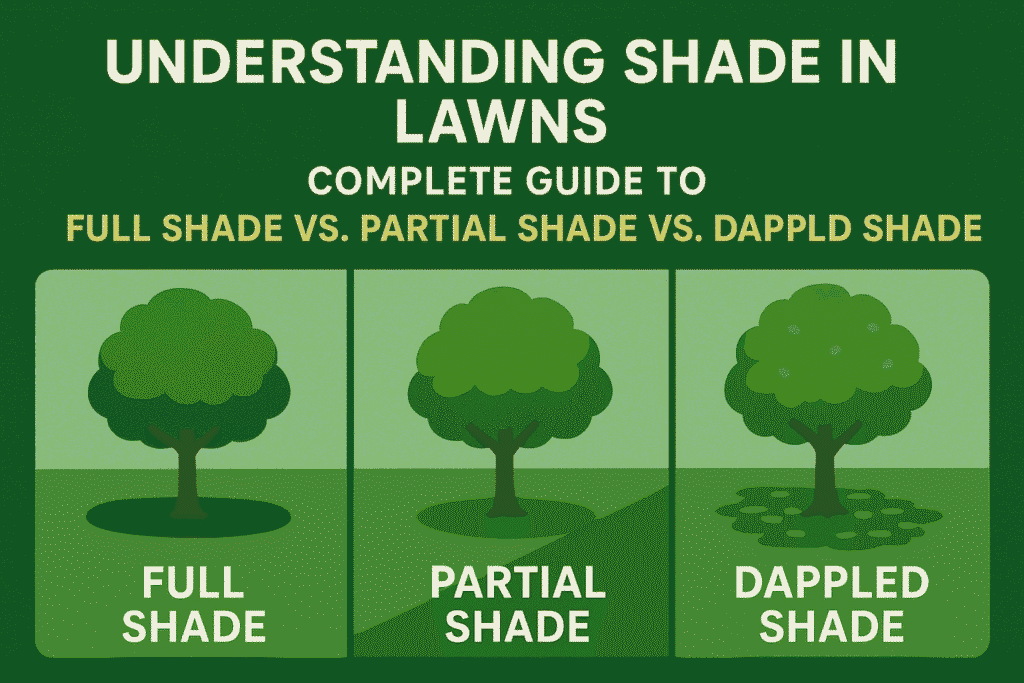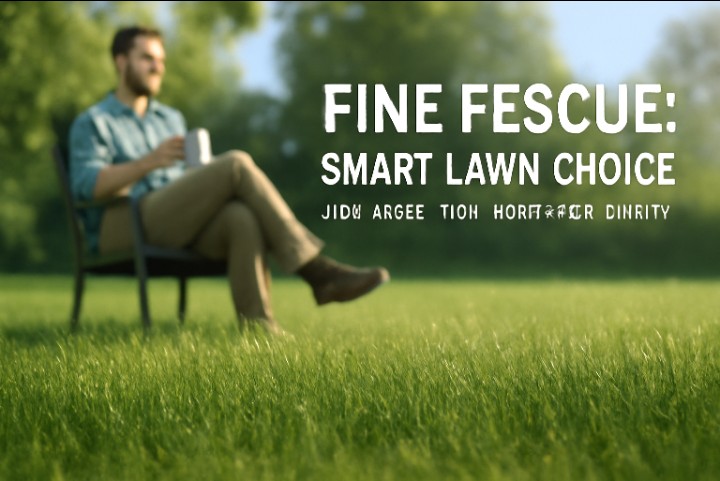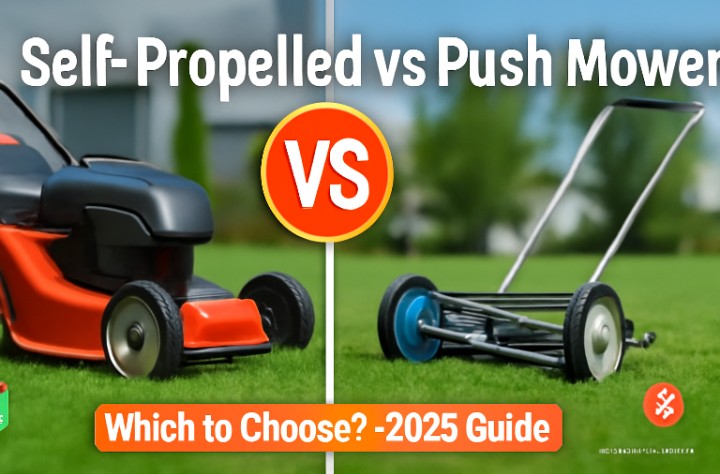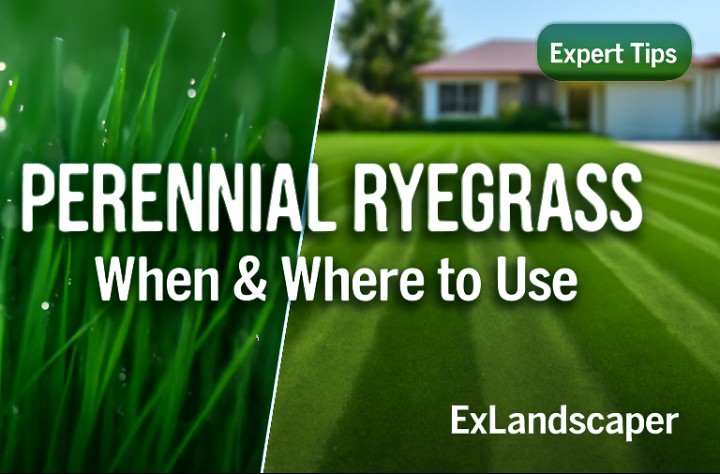What Type of Shade Do You Have?
Full Shade: Less than 3 hours direct sunlight daily
Partial Shade: 4-6 hours direct sunlight daily
Dapshade patterns throughout the day
Growing a healthy lawn in shaded areas feels challenging for many homeowners. You walk around your yard wondering why your grass looks thin under that maple tree. Or maybe you have tried planting grass near your deck, only to watch it struggle.
The truth is, shade does not have to mean lawn failure. Understanding different types of shade makes all the difference. Once you know what you are dealing with choosing the right grass becomes much easier.
Let me walk you through the three main shade types you will encounter. Each one needs a different approach, but all can support beautiful grass with the right strategy.
What Makes Shade Classification So Important for Lawn Health?
Understanding shade types determines grass variety selection, watering schedules, and maintenance practices that lead to successful shaded lawn establishment.
Many people think shade is just shade. This misconception leads to disappointment when expensive grass seed fails to thrive. The amount and quality of light your lawn receives determines everything from growth rate to disease resistance.
One of the key factors in successfully growing grass in shaded areas is choosing the right type of seed. This comes straight from Barenbrug’s latest research on shaded lawns.
Why Professional Landscapers Always Assess Shade First
Professional landscapers assess shade conditions before recommending any grass variety. They know that planting the wrong type in heavy shade wastes both time and money. Understanding your specific shade situation helps you make informed decisions from the start.
Full Shade: The Most Challenging Lawn Environment
Definition: Full shade areas receive less than three hours of direct sunlight daily.
Full shade means your lawn gets less than three hours of direct sunlight daily. These areas stay consistently dim throughout most of the day. You will find them on the north side of buildings, under dense evergreen trees, or between closely spaced structures.
Identifying Full Shade Characteristics
Walking through these areas, you will notice they feel cooler to the touch. The ground often stays moist longer after watering or rain. Light filters through rather than shining directly on the grass.
Best Grass Types for Full Shade Conditions
Arguably the most shade-tolerant grass out there, fine fescue basks in the shade, so to speak. Aaron Patton from Purdue’s Turfgrass Science Program explains this in his recent research.
Top Full Shade Grass Varieties:
– Fine Fescue varieties (Red Fescue, Chewing Fescue)
– Tall Fescue (moderate tolerance)
– Hard Fescue (shade mixture component)
Your grass options become limited in full shade. Fine fescues like Red Fescue and Chewing Fescue perform best here. These varieties evolved to thrive with minimal direct sunlight. Tall Fescue and Hard Fescue – These fescues are usually found in shade mixtures and have a great rep as grass seed for shade of medium density.
Realistic Expectations for Full Shade Lawns
Don’t expect the same thick, lush appearance you see in sunny lawns. Full shade areas typically develop thinner grass coverage. This is normal and doesn’t indicate failure if you have chosen appropriate varieties.
Partial Shade: The Sweet Spot for Most Grass Types
What is partial shade for lawns? Partial shade areas receive four to six hours of direct sunlight each day, creating optimal conditions for most shade-tolerant grass varieties.
Partial shade areas receive four to six hours of direct sunlight each day. These spots get morning sun with afternoon shade, or the reverse pattern. East and west-facing areas often fall into this category.
Understanding Partial Shade Light Patterns
You will notice bright periods followed by shaded periods throughout the day. The timing matters – morning sun with afternoon shade often works better than afternoon sun with morning shade.
Kentucky Bluegrass Shade-Tolerant Varieties
For Kentucky bluegrass, certain varieties are more shade tolerant than others. Shade tolerant varieties of KBG include; Glade, Nuggett, Liberator, Quantum, Compact Chateau, Coventry, Moonlight, Brilliant, Showcase and SR2000.
Perennial Ryegrass for Partial Shade Success
Perennial Ryegrass also performs well in partial shade. The highly recommended grass type here for low sunlight conditions is Perennial Ryegrass. This cultivar does not require extensive hours of direct sunlight like other varieties.
Warm-Season Grasses for Partial Shade
For warm-season areas, St. Augustinegrass is the most shade-tolerant of the warm-season grasses, followed by zoysiagrass. These varieties adapt well to changing light conditions throughout the day.
Most grass types can succeed in partial shade with proper care. This makes it the most versatile shade category for homeowners.
Dappled Shade: Managing Dynamic Light Conditions
What causes dappled shade? Dappled shade occurs when light filters through moving leaves or open structures, creating shifting sun and shade patterns throughout the day.
Dappled shade creates shifting patterns of sun and shade throughout the day. Light filters through moving leaves or open structures like pergolas. The patterns change as leaves move in the breeze or as the sun travels across the sky.
Common Dappled Shade Locations
You will see this under deciduous trees with open canopies. Oak trees often create beautiful dappled shade patterns. The light quality differs from solid shade because it includes periods of direct sunlight mixed with filtered light.
Seasonal Variations in Dappled Shade
Seasonal changes affect dappled shade dramatically. Spring offers more light before trees leaf out fully. Summer brings denser shade as foliage thickens. Fall opens up light again as leaves drop.
Best Grass Strategies for Dappled Shade
Most grass varieties adapt to dappled shade conditions. The key is choosing types that handle fluctuating light levels. Mixed seed approaches often work well since different grasses can dominate during different seasons.
How to Select the Right Grass for Your Specific Shade Type
Quick Selection Guide:
– Full Shade (0-3 hours sun): Fine Fescues only
– Partial Shade (4-6 hours sun): Kentucky Bluegrass, Perennial Ryegrass, St. Augustine
– Dappled Shade: Mixed seed blends, most adaptable varieties
Matching grass variety to shade level determines your success. Tall fescue has good shade tolerance, while Kentucky bluegrass is the least shade tolerant of the cool-season grasses. This comes from Missouri Extension’s latest guidelines.
Fine Fescues: Your Extreme Shade Solution
For extremely shaded areas, Fine Fescues remain your best option. They include Creeping Red Fescue, Chewing Fescue, and Hard Fescue varieties. These grasses grow slowly but maintain decent coverage where others fail.
Zoysia Grass Options for Warm Climates
Zoysia grass offers options for warm-season regions. Some good options for the shade include ‘Geo Zoysia’ and ‘Zeon.’ Those like ‘Emerald Zoysia’ are not as well-suited to the shade because they grow slowly and are easily choked out by more aggressive weeds, like crabgrass.
Regional Climate Considerations
Regional climate affects your choices significantly. Cool-season grasses dominate northern areas, while warm-season varieties work better in southern regions. Your local extension office can provide specific recommendations for your area.
Shade Lawn Mowing: Adjusting Your Approach for Success
How high should you mow grass in shade? Mow shaded lawns at 3-4 inches height to maximize photosynthesis and reduce weed competition.
Shaded lawns need different mowing strategies than sunny ones. Start by mowing high – 3 to 3.5 inches all summer – to encourage a deep root system and reduce weed problems. This advice comes from Nebraska Extension’s 2024 research.
Optimal Mowing Height for Shaded Areas
Set your mower blades higher for shaded lawns, ideally around 3 to 4 inches. Taller grass has more surface area for photosynthesis and can better compete with trees and other plants for resources.
Mowing Frequency Adjustments
Frequency changes too. Mow less frequently in shaded areas. Grass grows slower in shade, so it doesn’t need cutting as often. Follow the one-third rule: never remove more than one-third of the grass height in a single mowing session to prevent stressing the already challenged plants.
Blade Sharpness: Critical for Shade Success
Sharp blades become even more critical in shade. Clean cuts heal faster and resist disease better. Dull blades tear grass, creating entry points for fungal infections that thrive in humid, shaded conditions.
Watering Strategies That Work in Different Shade Types
How often should you water grass in shade? Shaded grass needs less frequent watering due to reduced evaporation, but requires careful moisture monitoring to prevent overwatering.
Shaded areas behave differently when it comes to water. Reduced evaporation means soil stays moist longer. This sounds good but can lead to overwatering problems.
Full Shade Watering Guidelines
Full shade areas need careful monitoring. The soil often stays wet while you think it needs more water. Check moisture levels by pushing your finger into the soil. If it feels moist two inches down, skip watering that day.
Partial Shade Water Management
Partial shade creates uneven moisture patterns. Areas that get morning sun dry faster than those shaded all day. You might need different watering schedules for different parts of your lawn.
Dappled Shade Watering Approach
Dappled shade areas usually need consistent moderate watering. The changing light patterns create more even moisture loss than solid shade areas.
Best Watering Timing for All Shade Types
Early morning watering works best for all shade types. This gives grass time to dry before nightfall, reducing disease risks that increase in humid, shaded conditions.
Common Shade Lawn Problems and Proven Solutions
Why is my grass thin in shaded areas? Thin grass coverage in shade results from reduced photosynthesis and is normal for shaded conditions when proper shade-tolerant varieties are used.
Thin Grass Coverage Issues
Thin grass coverage troubles many homeowners with shaded lawns. This often results from unrealistic expectations rather than actual failure. Shaded grass naturally grows less densely than grass in full sun.
Many lawns are mowed too short, allowing more light to reach the soil surface and encourage weed seeds to germinate. Proper mowing height helps maintain what coverage you have.
Preventing Fungal Diseases in Shade
Fungal diseases appear more frequently in shaded, humid conditions. Good air circulation helps prevent these issues. Remove low tree branches that block air movement. Avoid overwatering, which creates ideal conditions for fungal growth.
Moss Control in Shaded Lawns
Moss often indicates soil problems rather than just shade. Compacted, acidic soil encourages moss growth. Core aeration and pH adjustment can help grass compete better with moss.
When Grass Is not the Right Solution for Deep Shade
What grows in areas too shady for grass? Shade-tolerant ground covers like pachysandra, vinca, or mulched areas provide attractive alternatives to grass in extremely shaded locations.
Sometimes shade becomes too dense for any grass variety. Areas under large evergreen trees or between buildings might never receive enough light. Rather than fighting nature, consider alternatives.
Ground Cover Alternatives
Shade-tolerant ground covers like pachysandra or vinca work in extremely dark areas. These plants evolved for deep shade conditions and create attractive, low-maintenance coverage.
Hardscape Solutions
Mulched areas with decorative stones or wood chips offer another solution. These require no light and handle foot traffic better than struggling grass.
Creating Pathways Instead of Lawn
Pathways through heavily shaded areas often work better than attempting lawn coverage. Natural stone or wood chips create attractive walkways while eliminating maintenance challenges.
Timing Your Shade Lawn Projects for Maximum Success
When is the best time to plant grass in shade? Fall offers optimal conditions for establishing shade-tolerant grasses due to cooler temperatures and consistent moisture.
Fall: The Ideal Planting Season
Fall offers the best conditions for establishing shade-tolerant grasses. Cool temperatures and consistent moisture help seeds germinate without summer heat stress. Most shade-tolerant varieties prefer cooler growing conditions.
Spring Seeding Considerations
Spring seeding works for cool-season grasses but requires more careful watering. Hot summer weather can stress new seedlings before they establish strong root systems.
Overseeding Strategies
Overseeding existing thin areas works best in early fall. This gives new grass time to establish before winter dormancy. Spring overseeding can work but faces summer heat challenges.
Seasons to Avoid
Avoid starting shade lawn projects during summer heat or winter freeze periods. These extreme conditions stress even established grass, making new seeding much more difficult.
Setting Realistic Expectations for Shaded Lawn Success
What should I expect from grass grown in shade? Expect thinner coverage but healthy, quality grass when proper shade-tolerant varieties and care practices are used.
Success with shaded lawns requires adjusting your expectations. You won’t achieve the thick, lush coverage possible in full sun areas. This does not mean failure – it means working with natural conditions.
Quality Over Coverage Approach
Quality matters more than coverage in shaded areas. Dense, healthy grass in smaller areas often looks better than thin, struggling coverage over larger spaces. Focus on creating the best conditions possible rather than maximum coverage.
Patience for Shade Grass Development
Patience becomes essential with shade grass projects. Germination takes longer in low-light conditions. Growth rates stay slower throughout the growing season. Plan for gradual improvement over multiple seasons.
Working With Natural Conditions
Professional landscapers often recommend accepting shade limitations rather than fighting them. Working with your site’s natural conditions creates more sustainable, attractive results than constant battles against poor growing conditions.
Key Takeaways for Shade Lawn Success
Understanding your specific shade type helps you make better decisions about grass selection and care. Whether you are dealing with full shade, partial shade, or dappled shade, each situation offers possibilities for attractive lawn areas with the right approach.
Essential Points to Remember:
– Match grass variety to your specific shade level
– Adjust mowing height to 3-4 inches for shaded areas
– Water less frequently but monitor soil moisture carefully
– Set realistic expectations for coverage density
– Consider alternatives in extremely shaded areas






